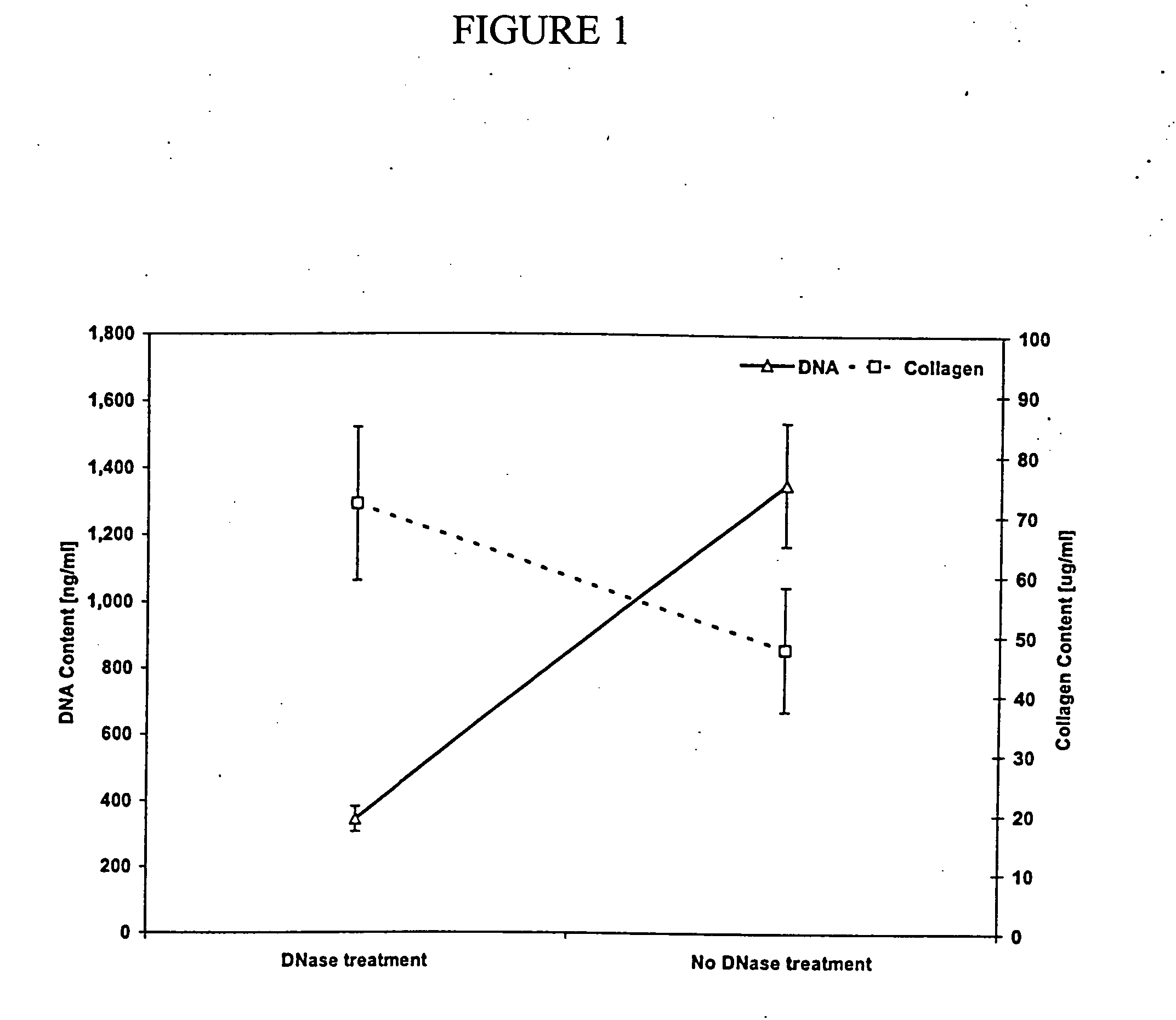Decellularized bone marrow extracellular matrix
a bone marrow and extracellular matrix technology, applied in the direction of prosthesis, drug composition, peptide, etc., can solve the problems of resuscitation, ineffective pharmacological therapy, scarring and loss of function,
- Summary
- Abstract
- Description
- Claims
- Application Information
AI Technical Summary
Benefits of technology
Problems solved by technology
Method used
Image
Examples
example 1
6.1 Example 1
[0117] First, a bone marrow sample is isolated from a pig or cow. Second, the bone marrow sample is filtered to remove bone spicules. Third, the remaining bone marrow sample is centrifuged in saline to remove the fat. Fourth, a non-ionic detergent is added to the remaining bone marrow sample to solubilize the cell membranes and any remaining fat. The remaining bone marrow sample is then rinsed with saline and filtered to remove the remaining extracellular matrix components. The rinsing step is repeated at least one time. Further, the remaining bone marrow sample is further treated with DNase and RNase to breakdown remaining nucleic acids and rinsed with saline to remove the remaining extracellular matrix components. Finally, the resulting extracellular matrix is sterilized using standard techniques in the art, e.g., peracetic acid (0.1%).
example 2
6.2 Example 2
[0118] First, a bone marrow sample is removed from the bone marrow cavity and the cortical bone by cutting, scooping, chiseling or sawing. The marrow is then reduced to small pieces by cutting, grinding, chopping, shearing, or crushing. The blood components are removed by rinsing, one or more times, in buffered saline or water. Next, the bone is separated from the ECM and any other remaining components by vigorous agitation (e.g., vortexing, shaking). After allowing the bone fragments to settle to the bottom, the non-bone components are removed by carefully decanting or aspirating (e.g., pipet). This process is repeated by adding more saline or water to the remaining bone. The non-bone components are treated with a combination of non-ionic detergent, acidic solution, alcohol solution, and basic solution to solubilize non-ECM components. Alternatively, the non-blood components are treated with an acidic or enzymatic solution (0.5 M acetic acid with pepsin 1 mg / ml). The s...
example 3
6.3 Example 3
[0119] 6.3.1 Isolation Procedure
[0120] Ribs and sternum from a freshly killed pig are collected and the cortical bone is removed. Large pieces of bone marrow are obtained by piercing, cutting and prying at the cortical bone-bone marrow interface with a sharp, stout knife. The large pieces of bone marrow are subsequently reduced in size to less than 5 mm on a side by cutting, crushing or shearing. Blood which remains in these pieces is rinsed away by multiple rinses using a buffered saline with protease inhibitor Protease-Arrest™ (Genotech, St. Louis, Mo.). For each rinse, the marrow is first placed in the solution and slowly agitated for 30 minutes. The rinsing solution is then removed from the bone marrow pieces with a pipet. Following the final rinse, more buffered saline with protease inhibitor Protease-Arrest™ is added to the bone marrow piece. The marrow is separated from the bone pieces by vigorous agitation with a standard lab vortex mixer. The resulting suspens...
PUM
| Property | Measurement | Unit |
|---|---|---|
| pore size | aaaaa | aaaaa |
| pore size | aaaaa | aaaaa |
| pH | aaaaa | aaaaa |
Abstract
Description
Claims
Application Information
 Login to View More
Login to View More - R&D
- Intellectual Property
- Life Sciences
- Materials
- Tech Scout
- Unparalleled Data Quality
- Higher Quality Content
- 60% Fewer Hallucinations
Browse by: Latest US Patents, China's latest patents, Technical Efficacy Thesaurus, Application Domain, Technology Topic, Popular Technical Reports.
© 2025 PatSnap. All rights reserved.Legal|Privacy policy|Modern Slavery Act Transparency Statement|Sitemap|About US| Contact US: help@patsnap.com

